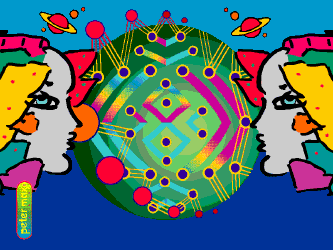| Constructivist Instruction Theoretical
foundation Contributions
|
1. Focus on learning through posing problems, exploring possible answers, and developing products and presentations 2. Pursue global goals that specify general abilities such as problem solving and research skills. 3. Stress more group work than individualized work. 4. Emphasize alternative learning and assessment methods: exploration of open-ended questions and scenarios, doing research and developing products; assessment by student portfolios, performance checklists, and tests with open-ended questions; and descriptive narratives written by teachers Constructivism challenges the traditional goals of education and proposes restructured, innovative teaching approaches. Constructivist goals focus on students' ability to solve real life, practical problems, and its methods call for students to construct knowledge themselves rather than dimply receiving it from knowledgeable teachers. The work of researchers and theorists such as Papert, Brown, Collins, and Duguid, CTGV, and Perkins have contributed especially important guidelines on how to develop instructional activities according to constructivist models. Problem-oriented activities. Most constructivist models focus on students solving problems, either in a specific content area such as mathematics or using an interdisciplinary approach. For example, such a problem might require a combination of mathematics, science, and language arts skills. Jungck (1991, p.155) says that constructivist methods frequently combine problem posing, problem solving, and persuasion of peers. Problems may be posed in terms of specific goals. (e.g., how to develop an information package to help persuade classmates to stop littering the beach), as "what if" questions (e.g., what would life be like on earth if we had half the gravity we now have?), or as open-ended questions (e.g., in light of what you know about the characters and the times in which they lived, what is the best ending for this story?). These kinds of problems are usually more complex than those associated with directed instruction and they require students to devote more time and more diverse skills to solve them. Visual formats and mental models. CTGV is especially concerned that instructional activities help students build good "mental models" of problems to be solved. They feel that teachers can promote this work most effectively by posing problems in visual, as opposed to written formats. These researchers say that "visual formats allow students to develop their own pattern recognition skills, and they are dynamic, rich, and spatial". This degree of visual support is felt to be particularly important for low-achieving, at-risk students who may have reading difficulties and for students with little expertise in the area in which the problems are posed. Rich, complex environments. Many constructivist approaches seem to call for what Perkins(1991) term "richer learning environments" in contrast to the minimalist classroom environment that usually relies primarily on the teacher, a textbook, and prepared materials. Perkins observes that many constructivist models are facilitated by combinations of five kinds of resources; information banks such as textbooks and electronic encyclopedias to access required information; symbol pads such as notebooks and lapto computers to support learners' short-term memories; construction kits, including legos, Tinkertoys, and Logo to let learners manipulate and build; phenomenaia (e.g., a terrarium or a computer simulation) toallow exploration; and task managers such as teachers and electronic tutors to provide assistance and feedback as students complete tasks. Cooperative or collaborative (group) learning. Most constructivist approaches heavily emphasize work in groups rather that as individuals to solve problems. This arrangement achieves several aims that advocates of constructivism and directed instruction alike consider important. CTGV observes that gathering students in cooperative groups seems to be the best way to facilitate generative learning. Perkins (1991) points out that cooperative learning illustrate distributive intelligence at work. In a distributive definition of intelligence, accomplishment is not a function simply of individual capabilities but the product of individuals and tools, each of which contributes to achieving desired goals. Finally, cooperative learning seems an ideal environment for students to learn how to share responsibility and work together toward common goals, skills they will find useful in a variety of settings outside school. Learning through exploration. All constructivist approaches call for some flexibility in achieving desired goals. Most stress exploration rather that merely getting the right answer and a high degree of what advocates of directed instruction call discovery learning. Authentic (performance-based) assessment methods. When the goals and methods of education change in the ways described here, teachers also need new methods of evaluating student progress. Thus, constructivist-learning environments exhibit more qualitative assessment strategies rather than quantitative ones. Some popular assessment methods center on student portfolios with examples of students' work and products they have developed; narratives written by teachers to describe each student's work habits and areas of strength and weakness; and performance-based assessments in combination with checklists of criteria for judging student performance.
|
 Characteristics
of Constructivist Instruction
Characteristics
of Constructivist Instruction